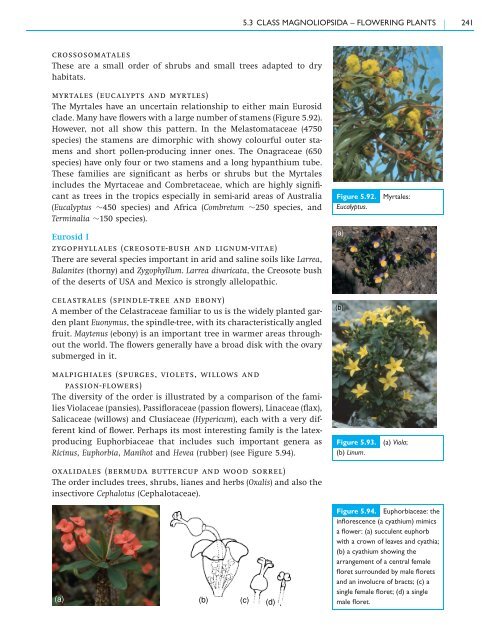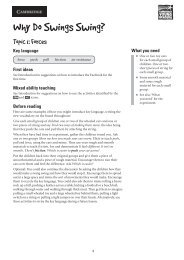5.3 Class Magnoliopsida – flowering plants - Cambridge University ...
5.3 Class Magnoliopsida – flowering plants - Cambridge University ...
5.3 Class Magnoliopsida – flowering plants - Cambridge University ...
Create successful ePaper yourself
Turn your PDF publications into a flip-book with our unique Google optimized e-Paper software.
crossosomatales<br />
These are a small order of shrubs and small trees adapted to dry<br />
habitats.<br />
myrtales (eucalypts and myrtles)<br />
The Myrtales have an uncertain relationship to either main Eurosid<br />
clade. Many have flowers with a large number of stamens (Figure 5.92).<br />
However, not all show this pattern. In the Melastomataceae (4750<br />
species) the stamens are dimorphic with showy colourful outer stamens<br />
and short pollen-producing inner ones. The Onagraceae (650<br />
species) have only four or two stamens and a long hypanthium tube.<br />
These families are significant as herbs or shrubs but the Myrtales<br />
includes the Myrtaceae and Combretaceae, which are highly significant<br />
as trees in the tropics especially in semi-arid areas of Australia<br />
(Eucalyptus ∼450 species) and Africa (Combretum ∼250 species, and<br />
Terminalia ∼150 species).<br />
Eurosid I<br />
zygophyllales (creosote-bush and lignum-vitae)<br />
There are several species important in arid and saline soils like Larrea,<br />
Balanites (thorny) and Zygophyllum. Larrea divaricata, the Creosote bush<br />
of the deserts of USA and Mexico is strongly allelopathic.<br />
celastrales (spindle-tree and ebony)<br />
A member of the Celastraceae familiar to us is the widely planted garden<br />
plant Euonymus, the spindle-tree, with its characteristically angled<br />
fruit. Maytenus (ebony) is an important tree in warmer areas throughout<br />
the world. The flowers generally have a broad disk with the ovary<br />
submerged in it.<br />
malpighiales (spurges, violets, willows and<br />
passion-flowers)<br />
The diversity of the order is illustrated by a comparison of the families<br />
Violaceae (pansies), Passifloraceae (passion flowers), Linaceae (flax),<br />
Salicaceae (willows) and Clusiaceae (Hypericum), each with a very different<br />
kind of flower. Perhaps its most interesting family is the latexproducing<br />
Euphorbiaceae that includes such important genera as<br />
Ricinus, Euphorbia, Manihot and Hevea (rubber) (see Figure 5.94).<br />
oxalidales (bermuda buttercup and wood sorrel)<br />
The order includes trees, shrubs, lianes and herbs (Oxalis) and also the<br />
insectivore Cephalotus (Cephalotaceae).<br />
(a) (b) (c) (d)<br />
<strong>5.3</strong> CLASS MAGNOLIOPSIDA <strong>–</strong> FLOWERING PLANTS 241<br />
Figure 5.92. Myrtales:<br />
Eucalyptus.<br />
(a)<br />
(b)<br />
Figure 5.93. (a) Viola;<br />
(b) Linum.<br />
Figure 5.94. Euphorbiaceae: the<br />
inflorescence (a cyathium) mimics<br />
a flower: (a) succulent euphorb<br />
with a crown of leaves and cyathia;<br />
(b) a cyathium showing the<br />
arrangement of a central female<br />
floret surrounded by male florets<br />
and an involucre of bracts; (c) a<br />
single female floret; (d) a single<br />
male floret.
















